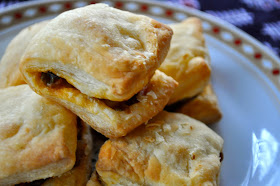A while ago, on one of my visits
to California, my friends and I went to Half Moon Bay. We were taking a leisurely stroll
along the water, after a late breakfast, catching up on news and events in each
others' lives. The water was too
cold for us to wade into, and so we decided to sit on the beach and enjoy the view.
This incident brought back memories of the numerous times my mom has packed puliyodharai for our travels. Whether we are going on a long train journey or on a day trip to some temple, she would pack chappatis or puris, potato curry, tamarind rice and curd rice. Sometimes, she would replace chappatis with idli and molagaipodi. She would wrap these in packets with banana leaves and newspaper, tied up with strings. By the time we ate the puliyodharai, the rice would have absorbed all the flavors, and the first mouthful lets you know that is was totally worth the wait!
While looking for a spot to sit,
we noticed this Indian family setting up their picnic lunch. They had several dubbas (containers)
and were getting ready for a feast.
One of those containers had puliyodharai or tamarind rice. We kept circling around them, talking loudly about how hungry we were, hoping to
get invited, but were completely ignored!
 |
| Puliyodharai - Tamarind Rice |
This incident brought back memories of the numerous times my mom has packed puliyodharai for our travels. Whether we are going on a long train journey or on a day trip to some temple, she would pack chappatis or puris, potato curry, tamarind rice and curd rice. Sometimes, she would replace chappatis with idli and molagaipodi. She would wrap these in packets with banana leaves and newspaper, tied up with strings. By the time we ate the puliyodharai, the rice would have absorbed all the flavors, and the first mouthful lets you know that is was totally worth the wait!
Below is my mom’s recipe for
pulikachal. My friend Anu’s mom
made Andhra style pulihora when I visited them recently. She made it very differently, but
it tasted fantastic. We devoured
several servings of pulihara followed by janthikalu over two days. I will post her recipe soon.
Here is what you need:
- ½ cup tightly packed tamarind
- 1st tempering
- 4 Tbsp. sesame oil
- 4 red chilies, crushed
- 2 tsp. mustard seeds
- 2 tsp. channa dal
- ½ tsp. hing (asafetida)
- few curry leaves
- Masala:
- 1 tsp. white sesame seeds
- 2 tsp. channa dal
- 2 tsp. dhania (coriander seeds)
- 1 tsp. pepper
- 4 - 6 red chilies
- 1 tsp. jeera (cumin seeds)
- ½ tsp. methi (fenugreek) seeds
- 2 cups basmati or sona masoori rice
- ¼ tsp. turmeric
- 2nd tempering
- 2 tsp. sesame oil
- ¼ cup cashew nuts
- ¼ cup peanuts
- few curry leaves
Here is how I made it:
- Soak the tamarind in about 2 – 3 cups of warm water and extract the juice.
- Heat oil for the first tempering. Add mustard seeds, channa dal, red chilies, curry leaves, and hing.
- When the mustard seeds sputter, gently add the tamarind juice and some salt to taste.
- Bring this to a boil, reduce heat to a medium-low and cook for about 10 – 15 minutes.
- While this is cooking, dry roast the sesame seeds. Set aside.
- Dry roast the rest of the masala ingredients. Let it cool.
- Grind the dry-roasted ingredients to a fine powder.
- Add this masala to the tamarind juice. Cook till this whole thing becomes a thickish paste (maybe 5 more minutes). Turn off the heat. You can save this paste in the fridge and mix it with rice when you need it.
- When you are ready to make the tamarind rice, cook the rice with a tiny bit of oil and turmeric powder. Let this cool. Make sure that the grains are separate. My mom would spread this out on a thambalam (really wide plate).
- Heat up the rest of the sesame oil. Add curry leaves, cashews and peanuts.
- When the cashews turn slightly brown turn off the heat. Mix it with the rice. Add the paste a little at a time to the rice and mix well.
With this quantity of paste, you can make about 3 - 4 cups of rice. It tastes best if you make this a few hours before you are ready to eat.
Serve with potato curry, chips, and papads. Goes great with avial too.





















